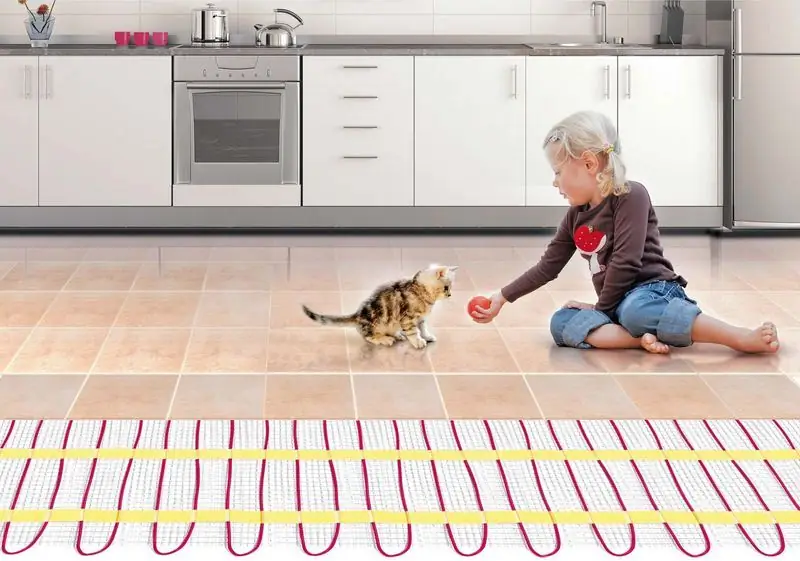
Table of contents:
- Author Bailey Albertson [email protected].
- Public 2023-12-17 12:53.
- Last modified 2025-06-01 07:32.
Warm floor in the kitchen under the tiles: choose and install

Not so long ago, underfloor heating systems were a rarity in apartments and houses, and now you will not surprise anyone with this. They can be used as additional heating for conventional radiator batteries or as independent heating equipment. Recently, there has been a persistent trend towards replacing radiator heating sources with more economical modern heating systems.
Content
-
1 Varieties of underfloor heating
- 1.1 Water floor
-
1.2 Electric floor
- 1.2.1 Cable
- 1.2.2 Film (infrared)
- 1.2.3 Rod
- 1.3 Video: types of underfloor heating
-
2 Recommendations for choosing a coating for underfloor heating
2.1 Video: choosing a covering for a warm floor
-
3 Installation of underfloor heating under tiles
3.1 Video: installing a warm floor
Varieties of underfloor heating
Underfloor heating is a flat heated surface that can be used in residential, industrial, office and office premises and even outdoors. In stores selling building and finishing materials, you can find several varieties of such systems.

Underfloor heating warms up the air in the room more evenly
Water floor
In underfloor heating water systems, hot water acts as a heat carrier, which can circulate inside the unit using pumps, as well as be supplied from centralized heating. The pipes, through which the working fluid moves, are laid over the entire surface of the floor in one or more contours on a layer of heat-insulating substrate, and from above they are covered with a wet or dry screed. The design of this thermostatic system is a kind of puff cake, with a thickness of 50 to 200 mm. The pipeline can be made of copper, metal-plastic, polypropylene or cross-linked polyethylene.

In water-heated floors, liquid acts as a heat carrier
The advantages of underfloor heating with a liquid heat carrier include the following qualities:
- Profitability. Noticeable savings in heat spent on heating (up to 50% for rooms with ceilings over 3 m).
- Environmental friendliness and safety. There is no electromagnetic field that has a negative impact on the inhabitants of the dwelling.
- Very low energy costs (pump only).
- Due to the low temperature of the energy carrier (+ 25 … + 45 ° C), it is possible to use any type of decorative flooring.
- The absence of bulky and not too attractive radiators, pipes and open wiring, which makes it possible to simplify interior decoration.
The negative qualities of water heating systems for floors are:
- The complexity, duration and high cost of installation work. The technology must be followed very strictly.
- A ban on installation in apartments, since the liquid goes to other residents almost cold, which upsets the overall balance.
- Installation restrictions in houses with weak floors. A thick layer of screed heavily makes the structure heavier and eats up the height of the ceilings.
- Inertia. The system takes a long time to warm up.
- The need to dismantle the screed to ensure free access to the pipeline in the event of a breakdown.
For the first time I saw heated floors at my friends' house. They made a water heating system by feeding it from a gas heating boiler. But it turned out that it was impossible to walk barefoot on the tile covering, which was placed on top, as it was very hot. With this adjustment, the temperature did not respond well and all households had to constantly wear slippers, which was not very convenient. After a couple of years, I had to dismantle everything and redo it again, as it was extremely uncomfortable.
Electric floor
There are several types of electrical systems for underfloor heating.
Cable
A single-core or two-core cable made of a high-resistance alloy (nichrome, etc.) that effectively converts electrical energy into thermal energy, is mounted in a cement screed up to 50 mm thick. To connect this electric floor, a 220 V network is sufficient, but the house wiring must withstand its power (80-150 W / m 2).

Underfloor heating cable system is the very first
Advantages of underfloor heating with cable:
- long service life (over 50 years);
- the ability to adjust the temperature;
- uniformity and speed of heating;
- democratic and affordable price.
Weaknesses inherent in cable underfloor heating:
- the presence of electromagnetic radiation (especially in cheap models);
- a ban on the installation of furniture over heated areas;
- the complexity of installation;
- high power consumption.
Film (infrared)
One of the most modern and effective is the infrared electric field, which is a thin (0.3-0.4 mm) film with heating elements laminated in it, which is a special paste based on carbon or carbon, as well as thin layers of metals (copper, aluminum). When connected to an electrical network, the emitters generate infrared radiation, which heats various objects, for example, flooring.

Foil underfloor heating is considered the most effective and economical
Positive qualities of the underfloor heating film:
- small thickness;
- the possibility of laying on any surface (horizontal, vertical, inclined);
- efficiency (high efficiency);
- ease of installation and no need to make a screed;
- high heating rate;
- in case of damage and failure of one section of the floor, all the others continue to function properly;
- noiselessness.
Negative characteristics:
- high price;
- impossibility of laying under a tile covering (poor adhesion).
Rod
A relatively new and not too widespread system, which in fact is a kind of infrared electric field. The heating elements are flexible composite rods made on the basis of silver, carbon or graphite, and placed 0.1 m parallel to each other. They are interconnected by a bus bar and embedded in a polymer film. A core underfloor heating is produced in the form of a roll thermomat.

Core underfloor heating is the latest development in this area
Pluses of the rod system:
- furniture and other heavy objects can be placed on such a floor;
- if one rod fails, other sections work;
- good heat dissipation;
- the possibility of filling with a screed and various adhesives, which is necessary for laying tiles;
- durability.
Cons can be considered:
- great price;
- high risk of buying a fake.
Video: types of warm floors
Recommendations for choosing a coating for underfloor heating
It is extremely important to correctly select the floor covering for the underfloor heating system. The material should serve for a long time, not deteriorate or deform under the influence of heat, and also not release toxic and toxic substances when heated. But the main requirement for a decorative finish floor covering will be the maximum thermal conductivity, so that all the generated heat is used to heat the room.
Various materials can be selected for underfloor heating:
-
Tile and porcelain stoneware. Ceramic coating is recognized as the best for underfloor heating, especially for systems with water heating. With a temperature difference, the expansion coefficient of the tile is small, and the stability is maximum. For underfloor heating, a low density tile material used in tiling is not suitable. It is better to choose a cladding with a hardness level of at least 5-6 class. You should not take tiles or porcelain stoneware under a film infrared floor, but there are models that allow you to use tiles.

Warm floor under the tiles Tile is considered the most suitable material for underfloor heating
-
Laminate. The next most popular facing material for heated floors. On sale there is a specially designed laminate flooring with increased thermal conductivity, it has a special designation on the packaging. You cannot use a conventional laminate with a porous structure and that does not have a binder and moisture-repellent impregnation resistant to thermal cycles of heating and cooling. Over time, the lamellas will inevitably crack. On the water floor, the laminate should be laid with care, choosing a product not lower than class 32 and up to 7 mm thick. In this case, the heating should be no higher than +30 ° C. Most often, a film underfloor heating is chosen for a laminated floor.

Warm floor under the laminate Under the laminate, infrared film underfloor heating is most often chosen
-
Linoleum. Not all types of linoleum are suitable for heated floors. When heated, toxic substances can be released, and the surface of the coating can deform due to the difference in thermal expansion of the layers. However, you can find thin materials that are suitable for this and have the appropriate markings.

Warm floor under linoleum Not all types of linoleum are suitable for underfloor heating
-
Bung. The cork coating has high thermal insulation characteristics, so there is often no point in using additional heating, moreover, it takes a long time to warm up. Prolonged use of such a warm floor and heating above +28 ° C will lead to overdrying and destruction of the cork.

Bung A warm floor is rarely installed under the cork.
-
Self-leveling coating. A very good option, since in terms of thermal conductivity, self-leveling floors are comparable to tiles. But it is economically unprofitable to use systems with a liquid heat carrier because of the large layer of the poured floor.

Self-leveling coating The warm floor is ideal for a decorative self-leveling floor covering
- Parquet, board. The least suitable facing material for heated floors, since it has a low thermal conductivity and a high coefficient of moisture and thermal expansion. It is allowed to use hard and resistant species (oak, teak, ash, acacia, etc.). Natural wood must be well dried (humidity not higher than 8%), it must not be heated more than +27 ° C. The board must be 15-16 mm thick, otherwise it simply won't heat up. Only infrared film is used.
Video: choosing a covering for a warm floor
Installation of underfloor heating under tiles
Before starting the installation work, it is necessary to draw up a project and draw a plan in which to take into account the location of furniture and plumbing fixtures, as well as to choose the location of the thermostat.
The further sequence of actions is as follows:
-
Preparation of the base. The old floor covering is dismantled. If necessary, if there are irregularities, make a rough screed (3-7 cm). Mount the temperature sensor in the floor and the thermostat on the wall (height 0.9-1 m).

Foundation preparation The base for underfloor heating must be carefully leveled
-
Thermal insulation. The entire concrete surface with an approach to the walls (5-10 cm) is covered with extruded polystyrene foam or foamed polyethylene foam. To compensate for thermal expansion, a damper tape is glued along the perimeter of the walls.

Thermal insulation A heat-insulating layer is laid on the prepared base
-
Underfloor heating installation. First, check the resistance and power for compliance with the passport data using a multimeter. The heating cable is laid with a snake, maintaining the same distance between the turns (10 cm) and 15-20 cm away from the walls. For fixing, use a special mounting tape with fasteners. Heating mats are simply spread over the surface of the base, the strips are fastened together with tape. Then the system is connected to the thermostat and checked again.

Underfloor heating installation The heating cable is laid with a snake
-
Laying tiles. First, a screed 3-5 cm thick is poured. After 2-3 days, when the solution has completely hardened, the tiles are laid on a special adhesive intended for warm floors and marked with a temperature range. On thermomats, the tile covering is laid immediately on the tile adhesive without screed.

Laying tiles You can skip the screed under the tile, it is immediately laid on the tile adhesive
Video: install a warm floor
The choice of underfloor heating systems, as well as decorative flooring for them, should be approached with all responsibility. It is equally important to correctly install heating equipment, strictly observing the technology of work.
Recommended:
How To Install A Warm Floor Electric, Infrared, Film Under Different Floor Coverings (with Video)
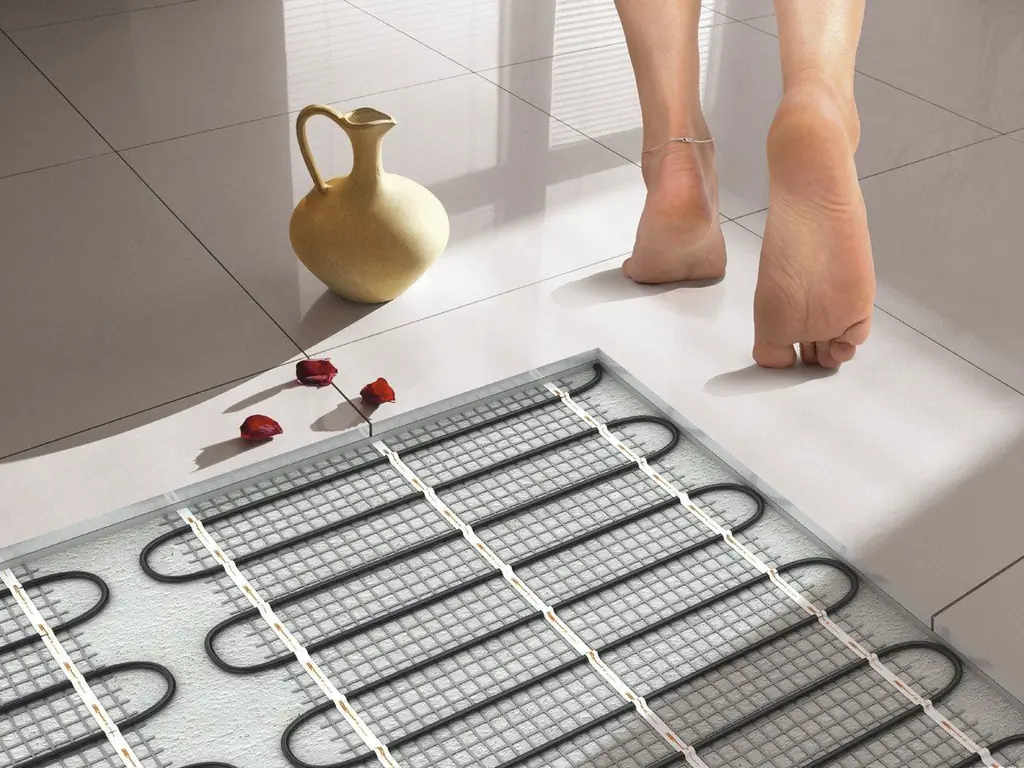
Installing a warm electric floor with your own hands. Practical advice on choosing the type of underfloor heating, recommendations for the installation of cable and film floors
MDF Doors: Entrance And Interior Doors, Their Varieties With A Description And Characteristics, Advantages And Disadvantages, As Well As Installation And Operation Features
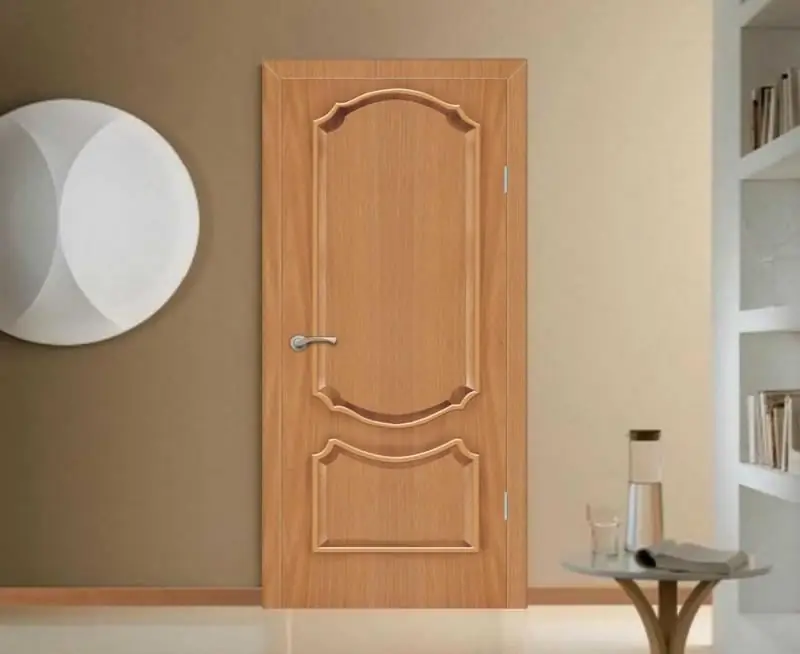
Doors from MDF: features, characteristics, varieties. Making and installing MDF doors with your own hands. Door restoration. Reviews, photos, videos
Ceramic Tiles 10x10 For The Kitchen: Features, Advantages And Disadvantages, Main Application, Examples With Photos
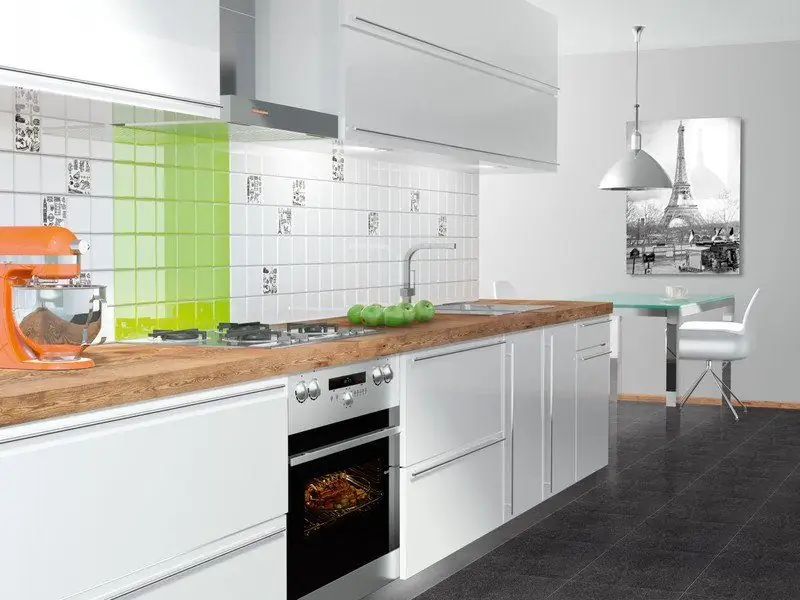
10x10 cm tiles: features, advantages and disadvantages. Selection recommendations. Kitchen design options with square tiles. Styling tips
Cement-sand Tiles, Advantages And Disadvantages, As Well As Installation Features

What are cement-sand tiles and what are their characteristics. Features of mounting the base for tiles. Tiled roof operating rules
Composite Tiles, Advantages And Disadvantages, Review Of Popular Brands With Descriptions, Characteristics And Reviews, As Well As Installation Features
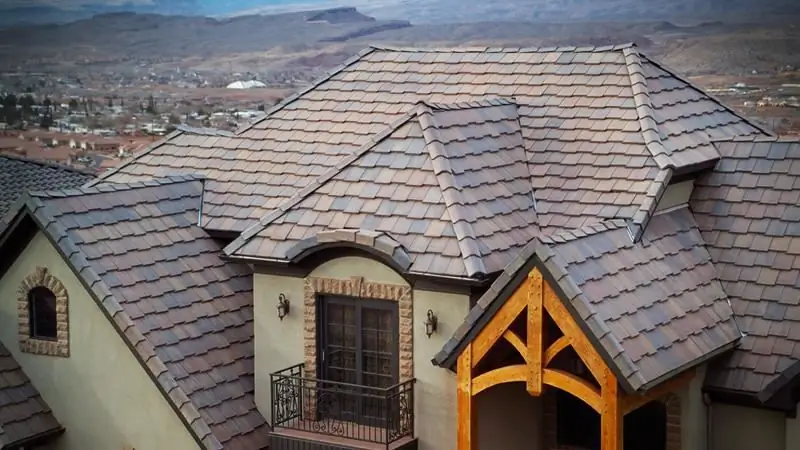
Composite shingles: history of use, characteristics, pros and cons. Features of installation. Review of popular brands. Reviews of builders and home owners
